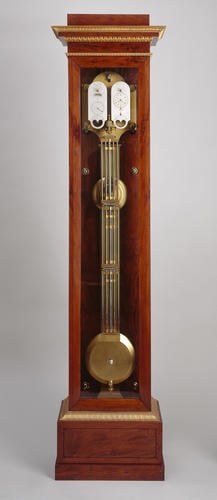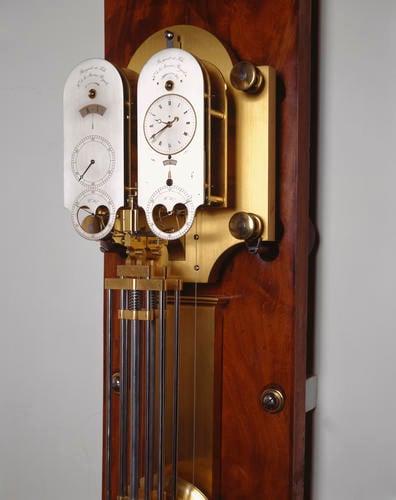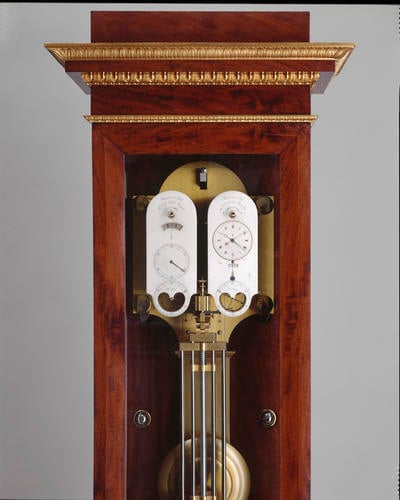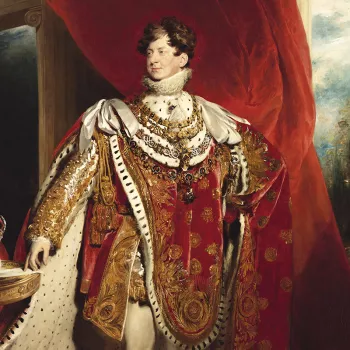Floor standing clock 1819-24
203.8 x 49.5 x 29.5 cm (whole object) | RCIN 2767
-
A long case astronomical clock in a mahogany and glass case with gilt bronze mouldings and a projecting cornice and plinth. The clock has two independent but identical movements incorporating two silvered dials, each with pinwheel escapements and jewelled pallets, and driven by a single heavy weight for both the barrels. The dials indicate apparent and mean time, the month and the day (right) and the time only (left). The second hand on the right dial moves anti-clockwise.
There are two pendulums identically constructed with zinc and steel compensation and brass bobs; each pendulum swings in the opposite direction to the other ensuring, by sympathetic action, that both movements remain extremely accurate; any error in time keeping by one is reduced by the other. In a regulator of high quality the sharing of any error by means of this refinement ensures almost perfect timekeeping. Also, by sealing the movements and pendulums behind glass pressures caused by the displacement of air are eliminated.
The case is fitted in the base with a box for burning charcoal which is linked to a zinc chimney running behind the mechanisms. Access to the oven is either through the hinged front panel of the base, operated by means of a spring catch, or by drawing the base forward from the back panel. The provision of the oven was viewed as an optional extra to be used to maintain a constant temperature.Provenance
Breguet was founded in 1775 by Abraham-Louis Breguet. His first known address was at 51 Quai de l'Horloge on the Île de la Cité in Paris. In 1807 his son, Antoine-Louis, became his partner and the business then became known as Breguet et Fils.
The firm exhibited a double pendulum clock in 1819 which was destined for 'the King of England'. With George III's failing health this proved not to be possible. However, after the death of the King, Antoine-Louis Breguet sent a drawing accompanied by a detailed description to George IV, who already had Breguet's 'Sympathique' synchroniser clock and watch. The clock was delivered from the Custom House to Carlton House on 19th September 1825 where it stood at the top of the Grand Stairway. Antoine-Louis received payment of £1,115 in July 1827.
In a covering memorandum dated 3rd October 1825 Antoine-Louis recorded 'Cet ouvrage unique est ce que nous avons fait de plus parfait et de plus extraordinaire, tant pour la Composition que pour sa belle exécution,..'.Included in the Pictorial Inventory of 1827-33 – RCIN 934776. The inventory was originally created as a record of the clocks, vases, candelabra and other miscellaneous items from Carlton House, as well as selected items from the stores at Buckingham House, the Royal Pavilion, Brighton, Hampton Court and Kensington Palace for consideration in the refurbishment of Windsor Castle.
-
Creator(s)
(clockmaker)(nationality)Acquirer(s)
-
Medium and techniques
Measurements
203.8 x 49.5 x 29.5 cm (whole object)
Alternative title(s)
Double pendulum regulator
Longcase clock
Place of Production
Paris [Île-de-France]











